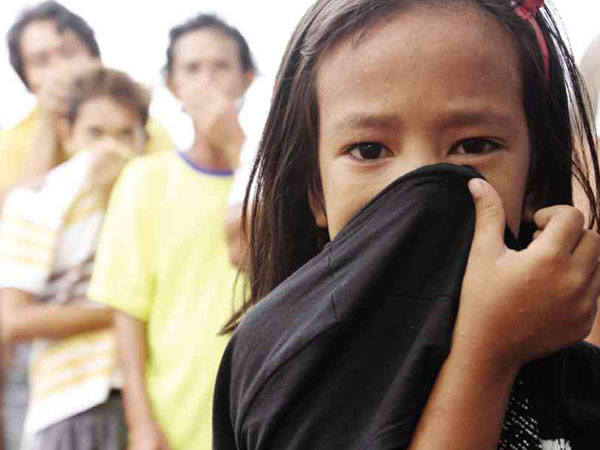
STENCH OF DEATH The smell of decomposing bodies in Barangay Santa Catalina, scene of heavy fighting in Zamboanga City between government forces and members of the Moro National Liberation Front, overpowers residents who have refused to leave their homes. EDWIN BACASMAS
ZAMBOANGA CITY—Death is in the air in the villages of Santa Catalina, Santa Barbara and Rio Hondo here, with the bodies of slain Moro National Liberation Front (MNLF) rebels rotting on the battlefield.
Col. Ignacio Obligacion, commander of Task Force Igsoon, said on Thursday he had been requesting the Crisis Management Committee, through the village officials, to send something to cover the stench.
“The stench has been there for days. I’m worried about an outbreak of disease,” Obligacion said.
One task force officer, who asked not to be named, said his unit had to end the fighting as quickly as possible because the stench had become unbearable.
In Santa Catalina, a group of policemen huddling and taking cover behind a wall said they saw bodies in the inner village. But recovering the bodies, they said, would be too risky because rebel snipers were in the area.
Almost all houses and other structures in the village have been razed during the fighting while debris and trash are scattered in the streets.
Structures that remain standing are riddled with bullets.
The streets are deserted except for the presence of government troops and military trucks.
Fighting goes on
But fighting continued on Wednesday, the 18th day of the standoff.
At dawn, successive loud explosions, believed to be an artillery attack by the Philippine Navy on Talon-Talon village, ripped the air.
The military said 40 rebels surrendered on Wednesday night and early on Thursday.
On Wednesday, two MNLF commanders and 32 followers also surrendered.
“I was surprised at the number of those who surrendered. That meant there were many of them here from the start,” Obligacion said.
Six hostages, mostly students, were also rescued.
But Obligacion said four soldiers were killed in the fighting on Wednesday night and early on Thursday.
Capt. Arvin Lawrence Llenaresas, commander of the 7th Scout Ranger Company, confirmed the surrender.
“There were fighters who surrendered to us carrying their firearms,” Llenaresas said.
“We are happy because we will see the end soon,” he added.
The surrenderers were taken to the Zamboanga City police station for booking and interrogation.
Early on Thursday, fires broke out in Rio Hondo and Sumatra Island, which is part of Talon-Talon.
The Philippine Navy also recovered a wooden hull that could accommodate 40 to 50 people and a motorboat that could carry about a hundred people.
Rebel forces
Lt. Col. Ramon Zagala, spokesman for the military, said 162 MNLF forces had been captured and 138 had been killed since the start of the crisis on Sept. 9.
Zagala said four MNLF commanders had been accounted for. Of the four, two—Usong Ugong and Salip Idjal—are alive. Two others—a certain Kumander Haider of Zamboanga Sibugay and Ismael Dasta of Basilan— were killed during the fighting.
Chief Insp. Ariel Huesca, spokesman for the Western Mindanao Command, said Haider was known as one of the chief commanders of MNLF leader Nur Misuari.
Huesca said Ener Misuari, who surrendered on Wednesday, was “just a follower” and not a commander, as earlier reported.
Phase 2
Interior Secretary Mar Roxas told a press briefing in the afternoon that the government would implement “Phase 2” of the operations after the fighting had ceased.
Phase 2, he said, would be clearing the area of bombs, booby traps and weapons.
“We will check all shallow graves for improvised explosive devices that may have been buried with the corpses,” Roxas said.
He said the displaced could not yet return to their villages. “We are not yet in Phase 2. We are still very much in Phase 1,” he said.
Roxas said the MNLF band was fast losing strength.
He said the 40 who surrendered early on Thursday claimed they had not eaten for three days.
“They are now shooting less, indicating they are low on ammunition,” he said.
Roxas confirmed the verification of the claims of the six rescued hostages that there were no remaining captives.
“They may not have seen the other hostages or the others could be in another village,” Roxas said.
End not seen yet
Roxas still could not say when the fighting would end.
“But we are doing our best. Step by step, not surges,” he said.
Roxas said 20 to 30 MNLF rebels were making a last stand in the Santa Barbara-Santa Catalina area and that Malik was there.
Obligacion said the area Roxas was referring to was Tres Alas in Santa Catalina.